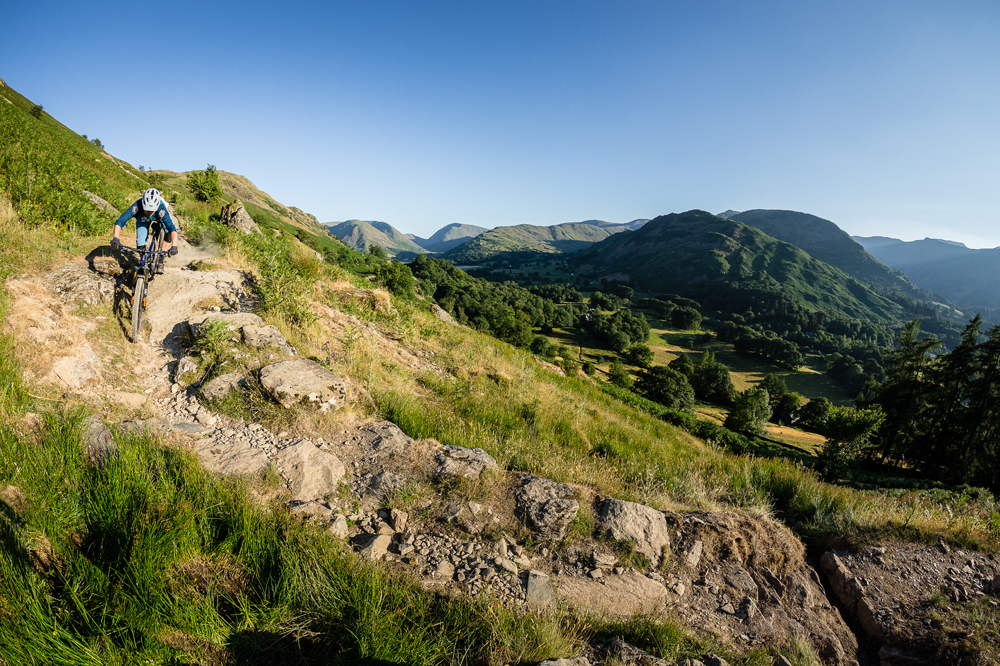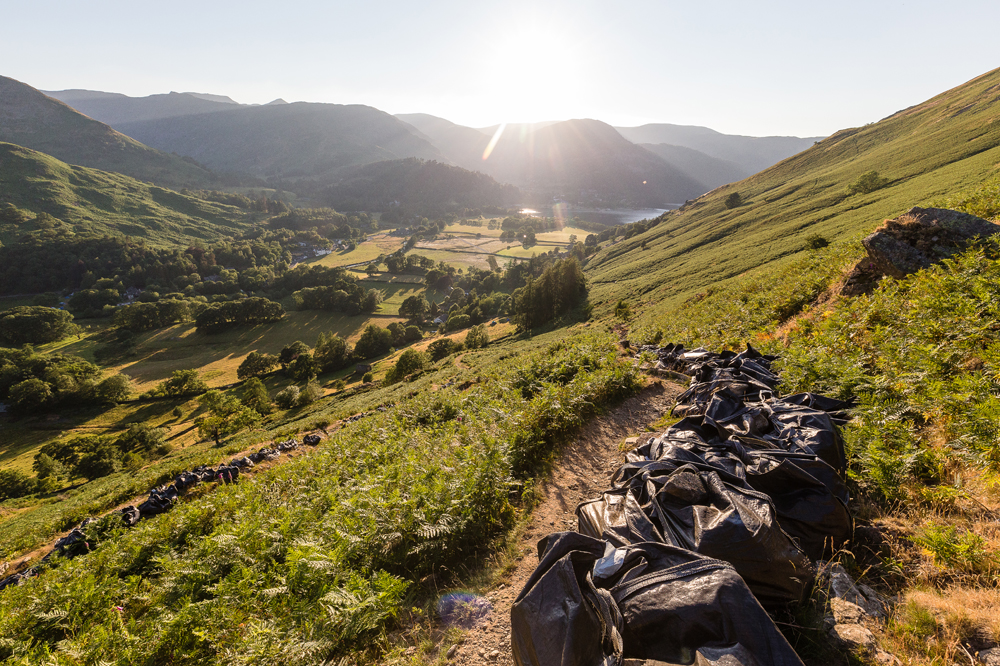Lakeland singletrack sanitised
[Originally published in mbr September 2018]
Across the Lake District, miles of challenging, technical singletrack is in danger of being stone pitched or widened, in some cases changing the look and character of the fells, and the trails we love, forever.
>>> 20 best mountain bike trails in the UK
Already places like Sticks Pass and Boredale Hause have been transformed.
Sanitised. Smoothed. Sustained? These words are being uttered on internet forums and huffed between gasps for air on lung-burning climbs in the Lakes. All are describing the new and controversial maintenance work being carried out on some of our favourite natural trails.
Some say its vandalism on a National Park level with former glorious trails turned into vast staircases, some say this is necessary for the preservation of these wild places. We say it needs discussion — mountain bikers need to know what’s going on, where, and who’s behind the work.

Accelerated wear necessitates stone pitching on steeper slopes
What is happening?
Stone pitching is causing the most concern. It’s a technique being used by Fix the Fells, a charity doing the works in the Lakes.It looks as it sounds, with stones set into the ground to provide a durable surface that’s not unlike a cobbled path, and is often stepped.
Stone pitching is used on gradients exceeding 15 or 30 per cent plus, where aggregate paths (suitable for 0-12 per cent) or aggregate retained by water bars (suitable for 8-15 per cent) would not be stable. (These figures are taken from the document Upland Pathwork – Construction Standards for Scotland published by the Upland Path Advisory Group, the document that Fix the Fells work to.)
Also in the toolkit is soil inversion, a type of aggregate path repair where the top few feet are turned over providing a firmer surface. Material is also removed from the sides of the path to create a ditch either side for drainage and it tends to leave a relatively smooth and loose surface. This has been deployed on the upper section of Sticks Pass.
While there are no doubts that sections do require ‘fixing’, many local mountain bikers argue that unnecessary work, at the expense of an area’s usage and aesthetics, should not be undertaken.
Natural features are being paved over by stone pitching or submerged beneath aggregate, and some trails are starting to look like motorways. Resurfacing often allows riders to travel at greater speed, which may put other users at risk. Aesthetically, renovated trails can create ill-fitting scars on the landscape, which even after re-vegetation are much more visible than their predecessors.
“Unfortunately stone pitching is the lesser of all the evils,” explains Joanne Backshall from Fix The Fells. “If you do nothing, people avoid the wet area and go wider and the path goes wider and deeper and those gulleys get wider and deeper.” she says. “At least this way it’s narrow and eventually vegetation grows up around it and it almost disappears from the land.”

Vegetation should eventually cover evidence of any maintenance work
Is maintenance really needed?
Yes, in a word. Increasing visitor numbers and traffic is causing accelerated wear on Lakeland bridleways. These old routes connect early rural settlements and historically allowed the transport of commodities and in some cases coffins. In the past they carried foot and hoof, now they take rubber and tungsten. Numbers are expected to continue to rise, following the areas recent award of UNESCO status.
It’s not just the extra traffic either, the climate is changing too. Severe weather is more common, like the severe flooding to the Glenridding area experienced during storm Desmond in 2015. Drainage systems were pushed beyond capacity and there were landslips along Boredale Hause. Inadequate or overloaded trail drainage can lead to water running off down the trail, further accelerating the erosion.
Many routes are being damaged by erosion, and while this may provide an inviting technical challenge for mountain bikers, it isn’t sustainable long term. Work is necessary to maintain the rights of way and improve drainage. It’s how that work is being carried out that’s causing the problem. Some believe the work is being over prescribed at the expense of the trails original character and charm.

Soil erosion is a prime concern of Fix The Fells
Who is Fix the Fells?
Fix the Fells is a charity division of the National Trust. As their name suggests, they raise money to carry out maintenance on the footpaths and bridleways of the Lake District. Along with Fix the Fells and the National Trust, work is also supported by the Lake District National Park Authority (LDNPA), Natural England, Friends of the Lake District and Nurture Lakeland.
Trails most under threat?
The current work on bridleways generating most concern is on Boredale Hause above Patterdale and the top section of Sticks Pass on the flanks of Raise, heading down to Greenside mines. There is an ongoing list of other sites to be fixed, the work schedule is published by Fix the Fells on their site. Be sure to keep an eye out here when planning rides to avoid having disruption on your routes.

Sanitised singletrack blunts the fun, but preservation is paramount
Where does that leave us?
The Lake District Mountain Bike Association (LDMBA) is a group of volunteers that aims to moderate change to off road rights of way in the Lakes. The group operates via a website and Facebook group, where issues are addressed and meets organised. We went for a ride with current chairman Geoff Cross to observe the modifications on Sticks Pass and gather his thoughts, and his vision for the future.
Geoff explained how the LDNPA intends to resurface many of the lowland bridleways in the area, with an aim to increase the number of people cycling on the roads to reduce congestion and increase safety for cyclists. As part of this scheme many of the lowland routes were to be made suitable for users on touring bikes.
Geoff’s opinion was balanced, agreeing with this policy he also tolerated necessary works on other higher altitude rights of way. Geoff has represented the voice of the LDMBA on the ground too, discussing works at Boredale Hause with the Fix the Fells team.

Where is the compromise?
The LDMBA has set up meetings to communicate mountain bike user’s requirements to Fix the Fells and some compromise has been made on Boredale Hause. Fix the Fells are striving to incorporate natural trail features into the ‘fixed’ bridleway such as working around sections of bedrock. They are also making use of small ford type cross trail drainage or waths as opposed to the water bar wheel killers.
“We really want people to use paths,” Joanne Backshall explains. “A lot of our guides are mountain bikers themselves. We all love the fells and we’re doing our best, we really want to do the right thing. Stone pitching is really the last resort but there just isn’t any other technique that works.”
What can you do to help?
Be pro-active, attend dig days, attend meets. Feet on the ground beats fingers on the keyboard.
Engage with Fix the Fells in writing, make your opinion known. Keep an eye on their ‘Paths to be fixed’ list.
If drainage is blocked mid-ride; make an effort to clear it. Functioning drainage systems preserve trails. Keep an open mind about trail repairs. We need to maintain the fells for the future use, not dwell on historical use. Climate change could lead to to more precipitation and faster erosion, so rights of way need to be future-proofed. But ultimately conservation and maintenance of the area’s charm is critical.
[Originally published in mbr September 2018]




